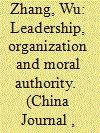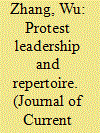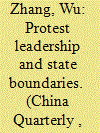| Srl | Item |
| 1 |
ID:
144374


|
|
|
|
|
| Summary/Abstract |
Despite a growing literature on peasant protest in contemporary China, we know little about why some protests are more sustained, disruptive and violent—in a word, militant—than others and thus pose a more serious challenge to the political order. The influential concept of “rightful resistance” cannot explain protest militancy, because it only applies to civil protest. This article studies a case of unusually militant peasant protest in Qizong, Hunan. The protest became militant because the peasants rallied around well-educated and fearless leaders and established a layered and encompassing protest organization. Empowered by central policies on lowering taxes and fees on the peasants (the so-called “peasant burden”) and the Confucian norm of subsistence, the peasants successfully mobilized for drastic reduction of the burden. Local government could not contain the protest, having lost its moral authority and lacking the resources either to suppress it or to make sufficient concessions.
|
|
|
|
|
|
|
|
|
|
|
|
|
|
|
|
| 2 |
ID:
121257


|
|
|
|
|
| Publication |
2013.
|
| Summary/Abstract |
Based on detailed ethnographic fieldwork, this paper compares two cases of peasant protest against heavy taxes and fees in a
northern Hunan county in the 1990s. It argues that peasant protest did
not arise spontaneously. Rather, it erupted when leaders emerged who
used central policy documents on lowering peasant taxes and fees to
mobilise peasants. Protest leaders were articulate and public-spirited
peasants who had received political training from the local party-state.
Furthermore, the number of leaders, their education level, and their relationship with the local party-state explain why the repertoire and the
scope of the two protests varied. Protests led by less educated veteran
Communist Party cadres tended to be milder and smaller than those led
by better-educated peasants more distant from the local party-state. This
paper helps us to understand the process of peasant mobilisation in contemporary China and explains why peasant protest varies across cases.
|
|
|
|
|
|
|
|
|
|
|
|
|
|
|
|
| 3 |
ID:
139558


|
|
|
|
|
| Summary/Abstract |
How does protest spread in contemporary China? This paper analyses one case of cross-firm protest and two cases of cross-village protest in order to demonstrate a mechanism for protest diffusion, a topic rarely studied in the existing literature. It argues that central policies, protest leadership and a connective structure that links protest leaders and followers enable people with shared economic interests to protest together. Protests emerged when protest leaders, who were trained politically by the state and enjoyed moral standing in a small community, started popularizing policy documents among followers. Protest diffusion occurred when representatives from each participating unit coordinated with one another and coalesced around the core leaders, who decided tactics for the entire protest. The protestors, however, did not form coalitions across different administrative boundaries. Thus, protest leaders did play a decisive role in the spreading of a protest. However, the state also moulded and restricted the scale of the diffusion.
|
|
|
|
|
|
|
|
|
|
|
|
|
|
|
|